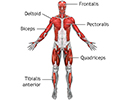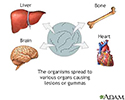Tabes dorsalis
Locomotor ataxia; Syphilitic myelopathy; Syphilitic myeloneuropathy; Myelopathy - syphilitic; Tabetic neurosyphilisTabes dorsalis is a complication of untreated syphilis that involves muscle weakness and abnormal sensations.
Syphilis
Syphilis is a bacterial infection that is most often spread through sexual contact.

Causes
Tabes dorsalis is a form of neurosyphilis, which is a complication of late-stage syphilis infection. Syphilis is a bacterial infection that is spread sexually.
Neurosyphilis
Neurosyphilis is a bacterial infection of the brain or spinal cord. It usually occurs in people who have had untreated syphilis for many years....

When syphilis is untreated, the bacteria may damage the spinal cord and peripheral nervous tissue. This leads to the symptoms of tabes dorsalis.
Peripheral
Peripheral means "away from the center. " It refers to areas away from the center of the body or a body part. For example, the hands are peripheral ...

Tabes dorsalis is now very rare because syphilis is usually treated early in the disease.
Symptoms
Symptoms of tabes dorsalis are caused by damage to the nervous system. Symptoms include any of the following:
- Abnormal sensations (paresthesia), often called lightning pains
Paresthesia
Numbness and tingling are abnormal sensations that can occur anywhere in your body, but they are often felt in your fingers, hands, feet, arms, or le...
 ImageRead Article Now Book Mark Article
ImageRead Article Now Book Mark Article - Problems walking due to nerve damage causing the person to walk with the legs far apart and feet slapping the ground
- Loss of coordination and reflexes
- Joint damage, especially to the knees
- Muscle weakness
- Vision changes
- Bladder control problems
- Sexual function problems
Exams and Tests
Your health care provider will perform a physical exam, focusing on the nervous system.
Physical exam
During a physical examination, a health care provider checks your body to determine if you do or do not have a physical problem. A physical examinati...

If syphilis infection is suspected, tests may include the following:
-
Cerebrospinal fluid (CSF-VDRL) exam
Cerebrospinal fluid (CSF-VDRL) exam
The CSF-VDRL test is used to help diagnose neurosyphilis. It looks for substances (proteins) called antibodies, which are sometimes produced by the ...
 ImageRead Article Now Book Mark Article
ImageRead Article Now Book Mark Article -
Head CT, spine CT, or MRI scans of the brain and spinal cord to rule out other diseases
Head CT
A head computed tomography (CT) scan uses many x-rays to create pictures of the head, including the skull, brain, eye sockets, and sinuses.
 ImageRead Article Now Book Mark Article
ImageRead Article Now Book Mark ArticleSpine CT
A lumbosacral spine CT is a computed tomography scan of the lower spine and surrounding tissues.
 ImageRead Article Now Book Mark Article
ImageRead Article Now Book Mark ArticleMRI
A magnetic resonance imaging (MRI) scan is an imaging test that uses powerful magnets and radio waves to create pictures of the body. It does not us...
 ImageRead Article Now Book Mark Article
ImageRead Article Now Book Mark Article -
Serum VDRL or serum RPR (used as a screening test for syphilis infection)
Serum VDRL
The VDRL test is a screening test for syphilis. It measures substances (proteins), called antibodies, which your body may produce if you have been i...
 ImageRead Article Now Book Mark Article
ImageRead Article Now Book Mark ArticleRPR
RPR (rapid plasma reagin) is a screening test for syphilis. It measures substances (proteins) called antibodies that are present in the blood of peo...
 ImageRead Article Now Book Mark Article
ImageRead Article Now Book Mark Article
If the serum VDRL or serum RPR test is positive, more tests are required to confirm the diagnosis.
Treatment
The goals of treatment are to cure the infection and slow the disease. Treating the infection helps prevent new nerve damage and may reduce symptoms. Treatment does not reverse existing nerve damage.
Medicines likely to be given include:
- Penicillin or other antibiotics for a long time to make sure the infection goes away
- Painkillers to control pain
Symptoms of existing nervous system damage need to be treated. People who are unable to eat, dress themselves, or take care of themselves may need help. Rehabilitation, physical therapy, and occupational therapy may help with muscle weakness.
Outlook (Prognosis)
Left untreated, tabes dorsalis may lead to disability.
Possible Complications
Complications may include:
-
Blindness
Blindness
Blindness is a lack of vision. It may also refer to a loss of vision that cannot be corrected with glasses or contact lenses. Partial blindness mean...
 ImageRead Article Now Book Mark Article
ImageRead Article Now Book Mark Article -
Paralysis
Paralysis
Muscle function loss is when a muscle does not work or move normally. The medical term for complete loss of muscle function is paralysis.
 ImageRead Article Now Book Mark Article
ImageRead Article Now Book Mark Article
When to Contact a Medical Professional
Contact your provider if you have:
-
Loss of coordination
Loss of coordination
Uncoordinated movement is due to a muscle control problem that causes an inability to coordinate movements. It leads to a jerky, unsteady, to-and-fr...
 ImageRead Article Now Book Mark Article
ImageRead Article Now Book Mark Article - Loss of muscle strength
-
Loss of sensation
Loss of sensation
Numbness and tingling are abnormal sensations that can occur anywhere in your body, but they are often felt in your fingers, hands, feet, arms, or le...
 ImageRead Article Now Book Mark Article
ImageRead Article Now Book Mark Article
Prevention
Proper treatment and follow-up of syphilis infections reduces the risk of developing tabes dorsalis.
If you are sexually active, practice safer sex and always use a condom.
All pregnant women should be screened for syphilis. Also, people at increased risk for getting syphilis should be screened for it. Common examples include men who have sex with men, people with HIV infection, young adults, and people with a history of incarceration, sex work, military service or illicit drug use.
References
Dionne JA, Ghanem KG. Syphilis. In: Goldman L, Cooney KA, eds. Goldman-Cecil Medicine. 27th ed. Philadelphia, PA: Elsevier; 2024:chap 295.
Radolf JD, Tramont EC, Salazar JC. Syphilis (Treponema pallidum). In: Bennett JE, Dolin R, Blaser MJ, eds. Mandell, Douglas, and Bennett's Principles and Practice of Infectious Diseases. 9th ed. Philadelphia, PA: Elsevier; 2020:chap 237.
US Preventive Services Task Force website. Syphilis infection in nonpregnant adolescents and adults: Screening. www.uspreventiveservicestaskforce.org/uspstf/announcements/final-recommendation-statement-screening-syphilis-infection-nonpregnant-adolescents-and-adults. Updated September 27, 2022. Accessed November 9, 2024.
-
Superficial anterior muscles - illustration
Superficial muscles are close to the surface of the skin. Muscles which lie closer to bone or internal organs are called deep muscles.
Superficial anterior muscles
illustration
-
Primary syphilis - illustration
Syphilis is a sexually transmitted disease caused by the bacterium Treponema pallidum. Primary syphilis presents as a small painless open sore 3 to 6 weeks after exposure. Although the lesion heals within 6 to 8 weeks, the untreated organism will continue to multiply unchecked, causing many complications. Infection may last for 30 years or more and result in severe neurological complications.
Primary syphilis
illustration
-
Late-stage syphilis - illustration
Tertiary syphilis is a late stage of the disease which can follow the initial infection, primary syphilis, by several years. Pockets of damage accumulate in various tissues such as the bones, skin, nervous tissue, heart, and arteries. These lesions are called gummas and are very destructive.
Late-stage syphilis
illustration
-
Superficial anterior muscles - illustration
Superficial muscles are close to the surface of the skin. Muscles which lie closer to bone or internal organs are called deep muscles.
Superficial anterior muscles
illustration
-
Primary syphilis - illustration
Syphilis is a sexually transmitted disease caused by the bacterium Treponema pallidum. Primary syphilis presents as a small painless open sore 3 to 6 weeks after exposure. Although the lesion heals within 6 to 8 weeks, the untreated organism will continue to multiply unchecked, causing many complications. Infection may last for 30 years or more and result in severe neurological complications.
Primary syphilis
illustration
-
Late-stage syphilis - illustration
Tertiary syphilis is a late stage of the disease which can follow the initial infection, primary syphilis, by several years. Pockets of damage accumulate in various tissues such as the bones, skin, nervous tissue, heart, and arteries. These lesions are called gummas and are very destructive.
Late-stage syphilis
illustration
Review Date: 8/29/2024
Reviewed By: Jatin M. Vyas, MD, PhD, Roy and Diana Vagelos Professor in Medicine, Columbia University Vagelos College of Physicians and Surgeons, Division of Infectious Diseases, Department of Medicine, New York, NY. Also reviewed by David C. Dugdale, MD, Medical Director, Brenda Conaway, Editorial Director, and the A.D.A.M. Editorial team.




